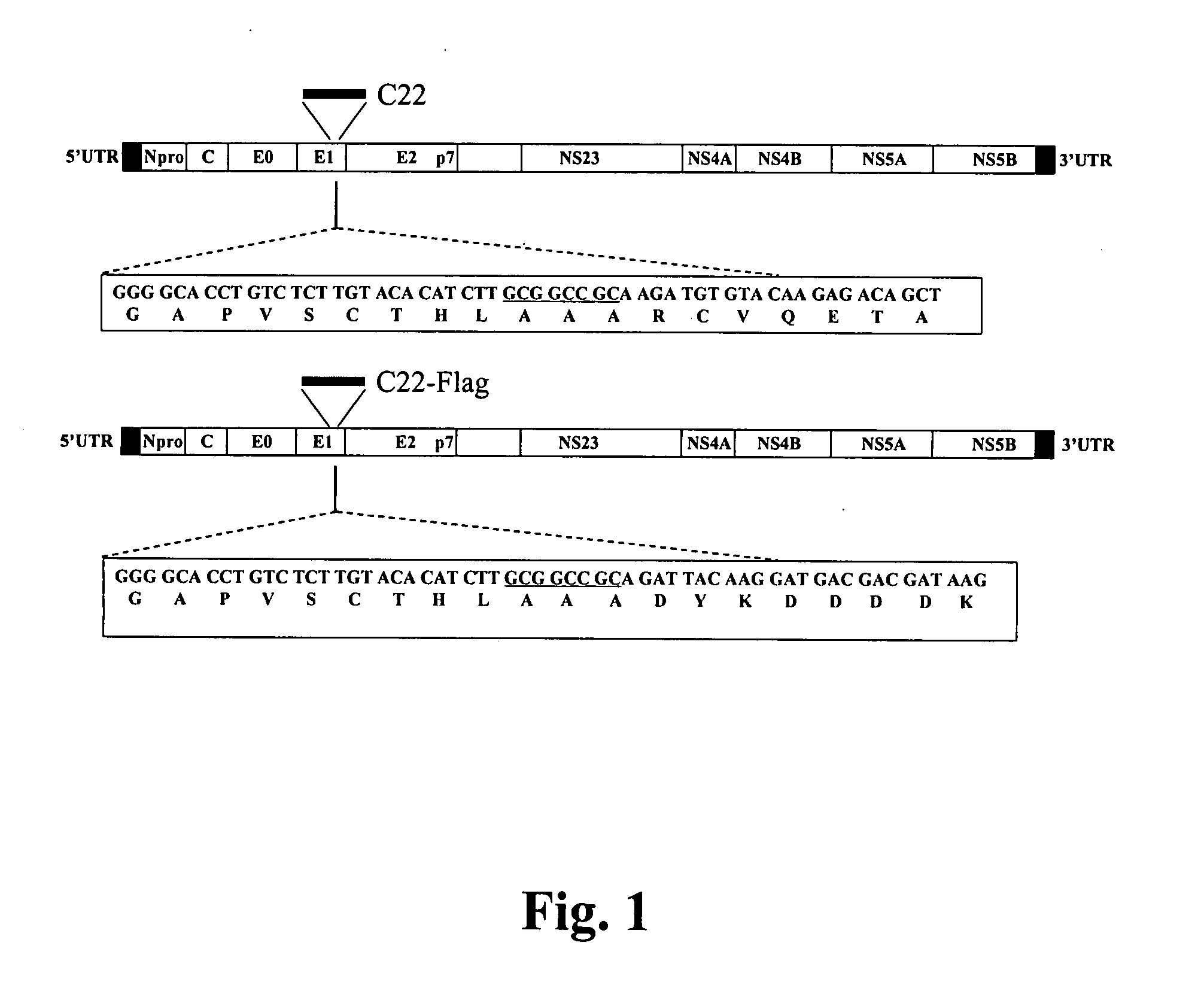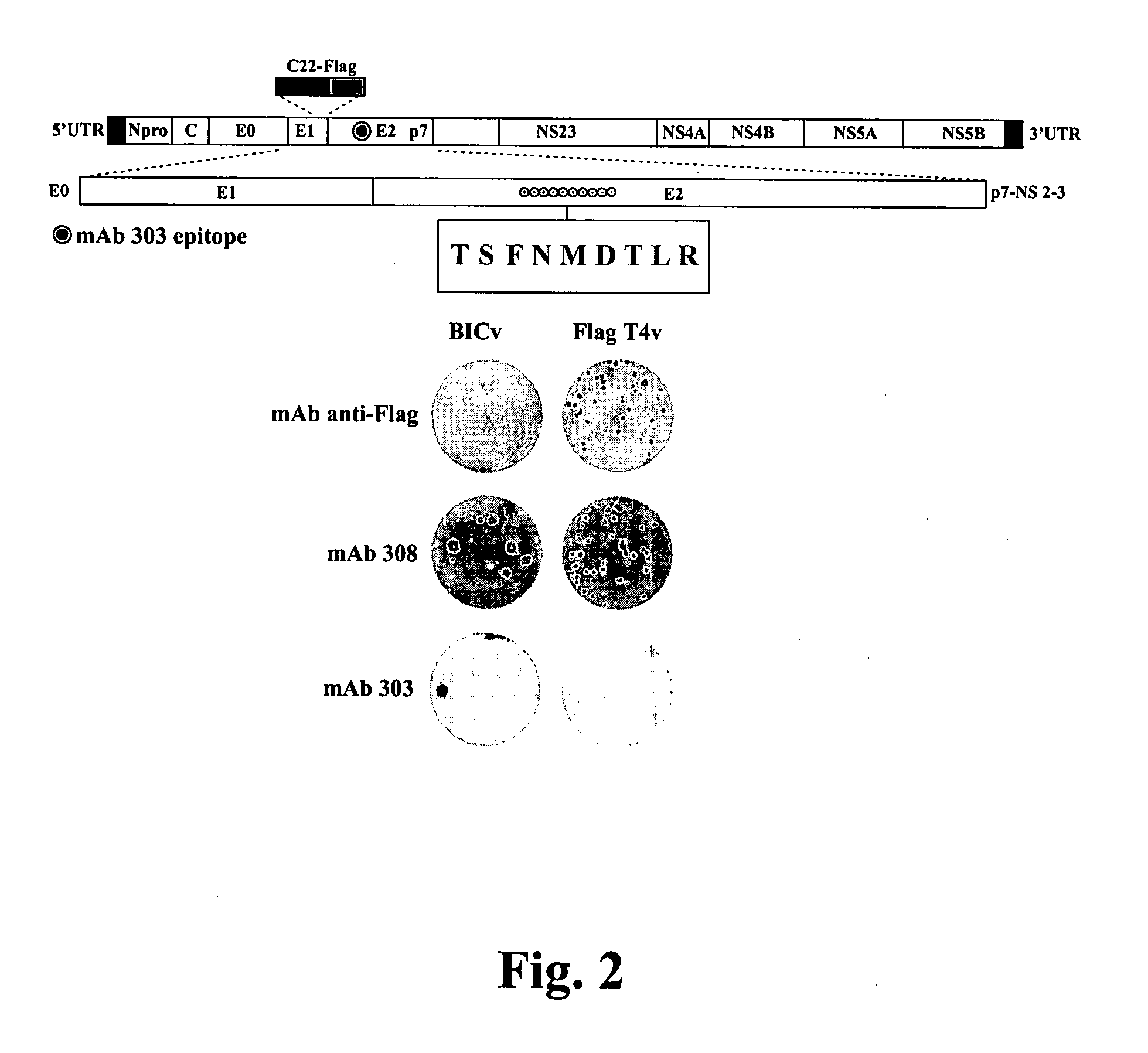Live attenuated antigenically marked classical swine fever virus
a swine fever virus and antigen-marking technology, applied in the field of double antigen-marking classical swine fever virus, can solve the problems of large animal population, significant economic loss, and inability to distinguish between animals, serologically
- Summary
- Abstract
- Description
- Claims
- Application Information
AI Technical Summary
Benefits of technology
Problems solved by technology
Method used
Image
Examples
example 1
Viruses and Cell Cultures
[0055]Swine kidney cells (SK6) (Terpstra et al. 1990. Dtsch. Tierarztl. Wochenschr. 97: 77-79), free of BVDV, were cultured in Dulbecco' minimal essential medium (DMEM) (Gibco, Grand Island, N.Y.) with 10% fetal calf serum (FCS) (Atlas Biologicals, Fort Collins, Colo.). CSFV Brescia strain was propagated in SK6 cells and used for the construction of an infectious cDNA clone (Risatti et al. 2005. J. Virol. 79: 3787-3796). Titration of CSFV from clinical samples was performed using SK6 cells in 96 well plates (Costar, Cambridge, Mass.). Viral infectivity was detected, after 4 days in culture, by immunoperoxidase assay using the CSFV monoclonal antibodies 174 (kindly provided by Georgina Ibata, Veterinary Laboratory Agency, UK) and the Vectastain ABC kit (Vector Laboratories, Buringames, Calif.). Titers were calculated using the method of Reed and Muench (1938. Amer. J. Hygiene 27: 493-497) and expressed as TCID50 / ml. As performed, test sensitivity was >1.8 TCI...
example 2
Construction of CSFV Flag-T4 Virus
[0056]A full-length CDNA copy of RB-C22v (Risatti et al. 2006., supra) was NotI-NheI digested and the excised 46 nucleotide fragment replaced with an oligonucleotide, forward sequence 5′GGCCGCAGATTACAAGGATGACGACGATAAGGGGGCACAAGGCCGG 3′ (SEQ ID NO:6) and reverse complementary sequence 5′CTAGCCGGCCTTGTGCCCCCTTATCGTCGTCATCCTTGTAATCTGC 3′ (SEQ ID NO:7), encoding for the flag epitope DYKDDDDK (bold case). One hundred pmoles of the forward and reverse oligonucleotides were annealed in buffer containing 10 mM Tris, pH 7.5-8.0, 50 mM NaCl, 1 mM EDTA. Oligos were heated at 95° C. for 5 min and cooled at room temperature for 30 min. Annealed oligonucleotides were directionally cloned into NotI-NheI-digested pRB-C22 using T4 DNA ligase (New England Biolabs, Beverley, Mass.). The introduction of mutations in amino acids at positions 829-834 of the CSFV polyprotein resulting in a shift of the Brescia amino acid sequence (TAVSPT) to the corresponding residues in ...
example 3
In Vitro Rescue of CSFV Brescia and Glycosylation Mutants
[0058]Full-length genomic infectious clones were linearized with SrfI and in vitro transcribed using the T7 Megascript system (Ambion, Austin, Tex.). RNA products were precipitated with LiCl and transfected into SK6 cells by electroporation at 500 volts, 720 ohms, 100 watts with a BTX 630 electroporator (BTX, San Diego, Calif.). Cells were plated in 12 well plates and incubated for 4 days at 37° C. and 5% CO2 atmosphere. Virus was detected by immunoperoxidase staining as described above and stocks of rescued viruses were stored at −70° C.
[0059]In vitro growth characteristics of FTv were evaluated relative to parental BICv in a single step growth curve. SK6 cell cultures were infected at a MOI of one TCID50 per cell. Virus was adsorbed for 1 h (time zero), and samples were collected at 48 h post-infection (PI). Results demonstrated that FTv exhibited growth characteristics practically indistinguishable from BICv reaching titers...
PUM
| Property | Measurement | Unit |
|---|---|---|
| Linear resolution | aaaaa | aaaaa |
| Linear resolution | aaaaa | aaaaa |
| Linear resolution | aaaaa | aaaaa |
Abstract
Description
Claims
Application Information
 Login to View More
Login to View More - R&D
- Intellectual Property
- Life Sciences
- Materials
- Tech Scout
- Unparalleled Data Quality
- Higher Quality Content
- 60% Fewer Hallucinations
Browse by: Latest US Patents, China's latest patents, Technical Efficacy Thesaurus, Application Domain, Technology Topic, Popular Technical Reports.
© 2025 PatSnap. All rights reserved.Legal|Privacy policy|Modern Slavery Act Transparency Statement|Sitemap|About US| Contact US: help@patsnap.com



